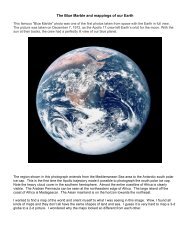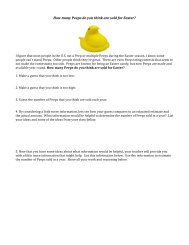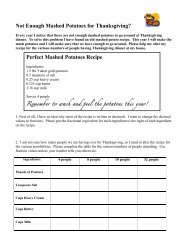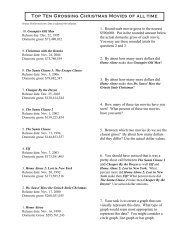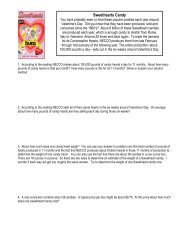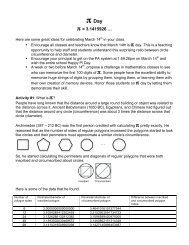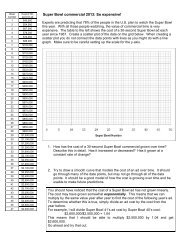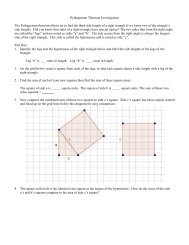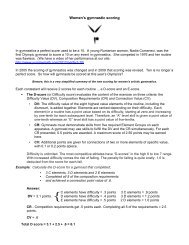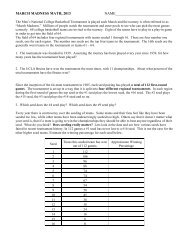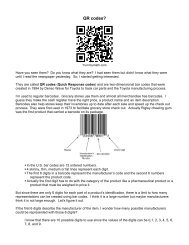Bits, Bytes, and Nibbles - Yummy Math
Bits, Bytes, and Nibbles - Yummy Math
Bits, Bytes, and Nibbles - Yummy Math
You also want an ePaper? Increase the reach of your titles
YUMPU automatically turns print PDFs into web optimized ePapers that Google loves.
00000 01000<br />
00001 01001<br />
00010 01010<br />
00011 01011<br />
00100 01100<br />
00101 01101<br />
00110 01110<br />
00111 01111<br />
3. Describe an easier way to have figured this out?<br />
4. Without counting any list of numbers, figure out how many different ways you could write a byte of<br />
information.<br />
So when someone wants to send a page of print electronically, they have to use a series of 0s <strong>and</strong> 1s<br />
that represent each of the letters or symbols that they are trying to convey. Each of those letters or<br />
symbols probably contains a byte of information. This could get huge.<br />
ASCII text (American St<strong>and</strong>ard Code for Information Interchange) is binary machine language. The<br />
letters, digits, common symbols, <strong>and</strong> some keystrokes all have binary symbols that are used to print,<br />
calculate, or render text. For instance, a capital “A” in ASCII is 100 0001. So it takes 7 bits to store a<br />
capital “A” in binary. 7 bits is pretty close to a byte. So, it is convenient to think that each character in<br />
English requires a byte for storage.<br />
5. Make a guess about how many bits of memory just one average-length word might require.<br />
Maybe we had better consider a larger grouping of information clusters than just a bit or byte. The next<br />
biggest capacity is a kilobyte (KB). A kilobyte of information contains 1,024 (2 10 bytes of information).<br />
One long paragraph of a typewritten page might contain 1 KB of binary (base 2) information.<br />
6. Take a guess at how large a grouping a digital book might require.<br />
I found that the Complete Works of Shakespeare would require 10MB of storage. That<br />
tomb has about 1,300 pages of print.<br />
7. Choose an average-sized book that you might read, calculate what fraction of<br />
the Complete Works of Shakespeare your book size is, <strong>and</strong> check your guessed<br />
answer to question 6.<br />
Photographs are even denser in file-storage-needs than printed information <strong>and</strong> require much more<br />
memory use. It’s interesting that printed text requires so much less memory than images. One page of<br />
print in an average paperback book might require 2 KB of storage. A low-resolution photograph might<br />
require 100 KB of storage <strong>and</strong> a high-resolution photograph 2 megabytes (MB = (2 10 ) 2 ) of storage.<br />
Uh oh ... a megabyte (MB).



